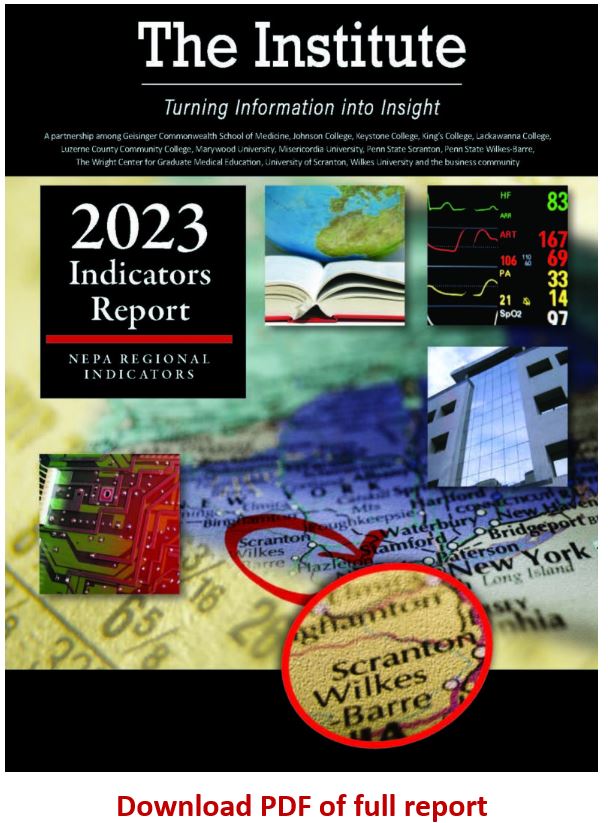Thank You
Thank you to the following organizations for their continued support of our research and this Data Dashboard, which is part of Project STIR (Sparking Transformation using Information & Research).
Commuting to Work
Driving alone remains the most common way to commute in both Lackawanna and Luzerne Counties. Prior to 2020, there had not been a significant change in the share of commuters driving to work alone, despite a decline between 2010 and 2019 in Lackawanna County. The second largest share of commuters have typically commuted by carpool, while public transit, walking, and other means normally comprised about five percent of commuters in the region and about 10 percent of commuters statewide.
A considerably large share of people worked from home in 2020 amid the COVID-19 pandemic. The share of those working at home statewide grew to 16.3 percent, and continued growing to nearly 19 percent in 2021, bringing down the share of those driving alone from 75 percent to 67 percent. In the region, there appears to be a similar shift underway, though multi-year estimates used in 2020 and for Wayne County still include pre-pandemic data, resulting in an underestimation of those working from home. In 2021, Lackawanna and Luzerne Counties each saw about 12 percent of workers telecommuting, and the percent driving alone decreased from about 79 percent to 73 percent.
2021 Lackawanna County Commuting Type
Source: US Census Bureau American Community Survey
2021 Luzerne County Commuting Type
Source: US Census Bureau American Community Survey
2021 Wayne County Commuting Type
Source: US Census Bureau American Community Survey
2021 PA Commuting Type
Source: US Census Bureau American Community Survey
Mean travel time to work (minutes)
Source: US Census Bureau American Community Survey
Transportation Mobility
The estimated share of households with no vehicles available has fluctuated in all three counties, averaging between 10 and 11 percent in Lackawanna County, Luzerne County, and statewide. In Wayne County, this share is only six percent.
% of Households with No Vehicle Available
Source: U.S. Census Bureau American Community Survey
Traffic Counts
In Lackawanna County, there are over 143 linear miles of highway that are part of the National Highway System. In Luzerne County, there are about 178 miles in the National Highway System, which includes interstate highways and certain other critical highways designated by the federal government. In 2021, Daily Vehicle Miles of Travel (DVMT, the total number of miles driven by all vehicles per day) on the National Highway System in the three counties was over 7.5 million – about 4.8 percent of the statewide DVMT.
The DVMT per mile of highway, a measure of average traffic volume, is lower than the statewide average in Lackawanna and Wayne Counties, but higher in Luzerne County. This trend was apparent both prior to and during the pandemic. As of 2021, vehicle miles traveled have nearly returned to pre-pandemic levels regionally and statewide.
The three-county region has several permanent traffic count sites that measure traffic volume and speed data on a continuous basis. The local sites include Interstate 81 in Wilkes-Barre Township, Interstate 80 in Foster Township, and State Route 307 in Newton Township. For the first time since 2016, data was available for the Foster Township location. In 2021, none was reported for the Wilkes-Barre Township location. Traffic counts at the Route 307 location increased by eight percent in 2021, consistent with increases in regional highway VMT, though traffic counts at that location remain lower than they were in 2015. On Interstate 80 in Foster Township, however, there was a significant increase in traffic counts between 2015 and 2021 – over 13 percent. Traffic counts are conducted less frequently in other locations within the three counties, so that data is not reported here.
Daily Vehicle Miles of Travel: 2021
Source: Pennsylvania Department of Transportation
| DVMT | National Highway Linear Miles | DVMT per Linear Mile | |
|---|---|---|---|
| Lackawanna | 3,043,458 | 143.8 | 21,164.5 |
| Luzerne | 4,347,177 | 177.8 | 24,449.8 |
| Wayne | 120,038 | 6.6 | 18,187.6 |
| Pennsylvania | 157,563,702 | 7,173.4 | 21,965.0 |
Bridges
In 2018, the Federal Highway Administration’s National Bridge Inventory changed its procedures for bridge evaluation and no longer reports the number of structurally deficient bridges. Instead, bridges are categorized as good, fair, or poor.
Throughout Lackawanna, Luzerne, and Wayne Counties, 1,074 bridges were counted in the 2022 National Bridge Inventory. Of those bridges, 23 percent, 26 percent, and 30 percent were classified as poor in Lackawanna, Luzerne, and Wayne Counties, respectively. For Luzerne and Wayne Counties, there is a marginal increase from the prior year, while the number of bridges in poor condition remained unchanged in Lackawanna County (at 364). All three counties have a considerably higher percentage of bridges in poor condition than the statewide percentage. In Pennsylvania as a whole, there has been a more marked decreasing trend in the share of bridges rated in poor condition, which declined to 13.4 percent in 2022.
% of Bridges in Poor Condition
Source: Federal Highway Administration National Bridge Inventory
Motor Vehicle Registrations
As of 2021, Lackawanna County passenger vehicle registrations have increased considerably compared to 2000. Luzerne County passenger car registrations have increased from 2020; in 2021, passenger car registrations rose to 195,732. In both counties, these totals were the highest among all years analyzed. In Wayne County, the total number of passenger car registrations decreased nine percent since 2000. Overall, the three-county region has seen a two-percent increase in passenger car registrations from 2000 to 2021, and growth of nearly two percent from 2020 to 2021. Statewide, there has been more consistent growth in passenger car registrations since 2000.
The three-county region has seen a generally increasing trend in the number of registered trucks over 5,000 pounds. In 2021, however, the number of the region’s registered trucks over 5,000 pounds decreased more than five percent from its 2020 totals. In contrast, the number of registered trucks over 5,000 pounds at the state level increased in 2021. The number of registered trucks under 5,000 pounds continued to decrease in the three counties and across the state, and it appears as though these trucks are being replaced by larger trucks in higher weight classifications. Since 2000, the number of registered trucks under 5,000 pounds has decreased by 64 percent in the three-county region and statewide.
Motor Vehicle Registrations: 3 County Region
| Registered in 2021 | Change Since 2020 | Change Since 2000 | |
|---|---|---|---|
| Cars | 352,654 | 1.6% | 2.1% |
| Motorcycles | 16,067 | 0.2% | 66.0% |
| Trucks < 5k lbs. | 17,139 | -3.7% | -64.1% |
| Trucks > 5k lbs. | 76,449 | -5.4% | 123.8% |
| Trailers | 63,811 | 2.1% | 59.2% |
Home Heating Fuels
According to the most recent data, utility gas remained the most widespread method of home heating fuel in Lackawanna and Luzerne Counties from 2000 to 2020. Since 2000, electricity has eclipsed fuel oil as the second largest home heating source. The share of homes heated by electricity increased in Lackawanna and Luzerne Counties in 2020 and 2021.
Fuel oil is Wayne County’s most widespread method of home heating fuel, though this share has decreased from 47 percent to 32 percent over the past 20 years. Compared to the other geographies, Wayne County also has a much higher share of homes using other fuels – this is largely comprised of homes heated by wood.
Statewide trends have been similar, with a slower shift toward electricity and a steady share of natural gas amid generally declining use of fuel oil.
Lackawanna Home Heating Fuel
Source: US Census Bureau American Community Survey
Luzerne Home Heating Fuel
Source: US Census Bureau American Community Survey
Wayne Home Heating Fuel
Source: US Census Bureau American Community Survey
Pennsylvania Home Heating Fuel
Source: US Census Bureau American Community Survey
Energy Price Trends
In 2022, all sources of heating energy increased in price. Natural gas increased by 24 percent, oil by 59 percent, propane by more than ten percent, and electricity by 36 percent. Oil, natural gas, and electric heating costs in 2022 were the highest they have been among all years analyzed. Propane costs were the highest seen since 2018. Natural gas prices have been less prone to large fluctuation and remain lower than the other fuel sources analyzed, despite the recent increases.
Energy Price Trends (in US Dollars)
Source: UGI Utilities
Airports
In 2019, the last full year before the COVID-19 pandemic disrupted travel, the total number of passengers traveling through Wilkes-Barre/Scranton International Airport grew to the largest number among all years analyzed, and nearly 39 percent higher than the passenger count recorded in 2013. In 2020, the passenger count fell by 62 percent to just under 222,000 passengers on 2,877 outbound flights. As of 2022, passenger counts continue to rebound, growing by nearly 23 percent from the prior year but remaining below pre-pandemic levels.
On-time performance, which has generally been on par with or slightly better than larger airports in the Mid-Atlantic region, has fluctuated without a clear trend. Flight delays and cancellations rose slightly 2022 after a decline in the prior year. Data reported by the Bureau of Transportation Statistics also indicated an increase in freight and mail volume at the airport, but still well below the freight volume seen prior to 2020.
Wilkes-Barre/Scranton International Airport Annual Statistics
Source: Wilkes-Barre/Scranton International Airport and Bureau of Transportation Statistics.
| 2010 | 2015 | 2016 | 2017 | 2018 | 2019 | 2020 | 2021 | 2022 | |
|---|---|---|---|---|---|---|---|---|---|
| Passengers | 433,972 | 434,127 | 462,999 | 531,854 | 527,928 | 590,044 | 221,781 | 313,107 | 384,371 |
| Outbound Flights | 5,977 | 4,781 | 4,823 | 4,822 | 5,557 | 6,051 | 2,877 | 3,037 | 3,065 |
| Freight/Mail (lbs.) | 453k | 351k | 369k | 340k | 403k | 238k | 3.6k | 2.5k | 8.3k |
| Carriers | 12 | 10 | 13 | 12 | 13 | 12 | 10 | 9 | 10 |
| % On Time | |||||||||
| Departure | 80% | 84% | 87% | 83% | 81% | 84% | 82% | 86% | 81% |
| Arrival | 75% | 75% | 83% | 81% | 79% | 79% | 81% | 83% | 77% |
| Average Delay (minutes) | |||||||||
| Departure | 71.91 | 84.26 | 93.64 | 126.15 | 88.49 | 92.95 | 99.32 | 77.53 | 88.74 |
| Arrival | 61.5 | 55.66 | 65.73 | 71.44 | 62.89 | 64.26 | 65.93 | 49.75 | 67.05 |
| % Cancelled | 3% | 2% | 2% | 2% | 3% | 2% | 7% | 2% | 3% |
| # of Carriers Reporting | 6 | 2 | 3 | 3 | 7 | 6 | 7 | 5 | 5 |
Broadband Access
The share of households with any internet subscription has been growing since detailed data has been kept by the Census Bureau. As of 2021, about 87 percent of households in Lackawanna and Luzerne Counties had internet access – slightly more than Wayne County (84 percent) but lower than the statewide rate of 89 percent. While internet access is less widespread among lower income households, over two-thirds of regional households with annual income under $20,000 have internet access. At the state level, about 71 percent of households with annual income under $20,000 have internet access.
As of 2021, over 84 percent of households in Lackawanna and Luzerne Counties have smartphones – a proportion that grew considerably from 66 percent in 2016. Wayne County has a slightly lower rate of smartphone availability, at 75 percent, but all three counties have seen consistent increases in this share where data is available. In Lackawanna and Luzerne Counties, the percentages of households with smartphones have nearly equaled the shares of households with any internet subscriptions.
Households with Any Internet Subscription
Source: U.S. Census Bureau American Community Survey
Households with a Smartphone
Source: U.S. Census Bureau American Community Survey








 Sarah, a former Institute intern, joined The Institute in April 2021 as a Research Assistant. She started her new role as a Research Analyst in January 2024.
Sarah, a former Institute intern, joined The Institute in April 2021 as a Research Assistant. She started her new role as a Research Analyst in January 2024. 

 Jill Avery-Stoss joined The Institute in June 2018 to fill the newly-created role of Research, Data, Intern & Administrative Coordinator. She assists with the collection and management of data for purposes of ethical and efficient analysis. She visits partner campuses to market The Institute’s internship opportunities, and participates in event-planning logistical activities as well. In 2021, Jill was promoted to Director of Operations to reflect the diversity in her job description and the additional marketing and communication functions she successfully mastered in 2020. In 2022, Jill was named Chief Operating Officer after expanding into both research and administrative management functions. Jill is taking on project management, fundraising, and other executive leadership functions of the organization.
Jill Avery-Stoss joined The Institute in June 2018 to fill the newly-created role of Research, Data, Intern & Administrative Coordinator. She assists with the collection and management of data for purposes of ethical and efficient analysis. She visits partner campuses to market The Institute’s internship opportunities, and participates in event-planning logistical activities as well. In 2021, Jill was promoted to Director of Operations to reflect the diversity in her job description and the additional marketing and communication functions she successfully mastered in 2020. In 2022, Jill was named Chief Operating Officer after expanding into both research and administrative management functions. Jill is taking on project management, fundraising, and other executive leadership functions of the organization. Ooms is responsible for all facets of research, organizational strategy, and management. Ooms is an active principal investigator in all Institute research. Ooms has been nationally recognized as a leader in regional economic development. She turned that skill into a research institute to help other regions develop and prosper. Her strategic skills have allowed The Institute to expand its services to the private and non-profit sectors for research and analysis in community health needs assessments, strategic planning, market and feasibility studies, and economic impact analysis.
Ooms is responsible for all facets of research, organizational strategy, and management. Ooms is an active principal investigator in all Institute research. Ooms has been nationally recognized as a leader in regional economic development. She turned that skill into a research institute to help other regions develop and prosper. Her strategic skills have allowed The Institute to expand its services to the private and non-profit sectors for research and analysis in community health needs assessments, strategic planning, market and feasibility studies, and economic impact analysis.